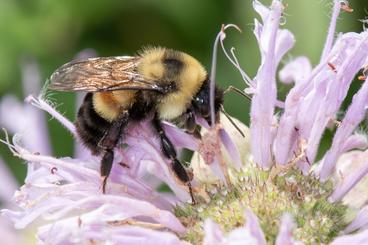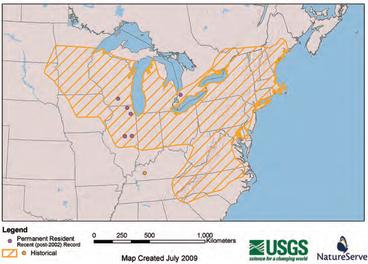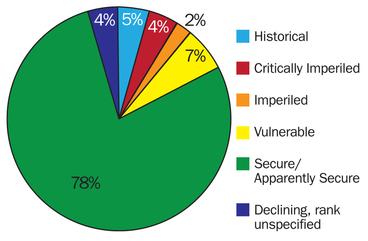
Bumble bees are annual species. The spring to late summer period of colony founding, build up, and production of reproductive individuals, followed by the overwintering of new queens provide the natural history basis for management considerations of the approximately 46 North American species. Eight species from three subgenera, however, have declined drastically during the last 15‐20 years. These include three species that are obligate parasites on other declining species. Specifically, the rusty patched bumble bee has declined by 87 percent in the last 20 years. The species is likely to be present in only 0.1% of its historical range and is a federally endangered species (USFWS, 2017).
There are many potential reasons for the rusty patched bumble bee decline including habitat loss, intensive farming, disease, pesticide use and climate change. With the odds seemingly stacked against the rusty patched bumble bee, there is a role for everyone in conserving this beneficial pollinator. Your actions will also help a host of bees, butterflies and birds that share resources with the rusty patched bumble bee.
The rusty patched bumble bee is a relatively large, black and yellow bumble bee. Queens are 20–22 mm (0.79–0.87 in.) in length with no orange band. Workers have orange bands and are smaller, reaching 13–17.5 mm (0.52–0.69 in.) in length. Male drones have orange bands and are slightly bigger than the female workers.
In 2020 Minnesota’s official state bee made a rare city appearance. Rusty patched bumble bees were discovered in prairie flower plantings by Bloomington Civic Plaza, 1800 West Old Shakopee Road. U.S. Fish and Wildlife Service Urban Biologist Nicole Menard found five rusty patched bumble bees foraging on wild bergamot, a Minnesota native plant known to attract pollinators. This discovery shows how prairie restorations, such as the ones the city of Bloomington has completed in recent years, can attract a wide variety of beneficial insects.


How to manage pests while conserveing the rusty patched bumble bee
- Use contact insecticides on flowering plants, such as bifenthrin, cyfluthrin, Bt, soaps, or insect growth regulators.
- Do not use systemic insecticides.
- Plant a seasonal phenology of native and garden plants for nectar and pollen.
- Only single-flowered plants, not double flowers, provide pollen and nectar.
- Provide overwintering habitat for bees.
- Do not kill queen bees in the spring/fall, they will not sting.
- Understand the different types of bees and wasps so you can conserve bees.
- Use IPM, including cultural methods to modify the habitat to help bumblebees:
- Bumblebees nest in rodent dens underground and above ground.
- Do not remove downed trees, brush piles, dead trees, and winter grasses.
- Coexist with BB colonies as they are passive and do not sting and chase people like wasps.
- Retrofit landscapes to include season long pollinator plants
- Do not use toxic conventional or organic insecticides; switch to biorational insecticides
- Stop using herbicides as they have been shown to decrease bumble bee colonies.
- Use on spot treatments of fungicides as they have been shown to decrease bumble bee colonies.
- If absolutely necessary, only use biorational insecticides, fungicides, and herbicides.
Bee Lawns
Bee lawns are made of a mix of grasses and low-growing perennials that can be used and treated much like a regular lawn, but also offer high-quality nutrition to pollinators. In 2019, the Minnesota Legislature funded the Lawns to Legumes project, which provided dollars for workshops, planting guides and some city and individual project funding to encourage homeowners to replace lawn areas with pollinator-friendly plantings, which can vary from small pocket plantings to full meadows.
Bee lawns can be established virtually anywhere, but are best in areas that are not heavily used for recreational purposes or that are primarily aesthetic like boulevards, steep slopes, and right of ways or easements.